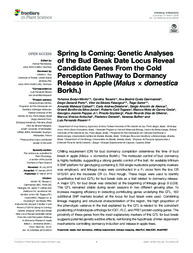Spring is coming: genetic analyses of the bud break date locus reveal candidate genes from the cold perception pathway to dormancy release in apple (Malus x domestica Borkh.)
Spring is coming: genetic analyses of the bud break date locus reveal candidate genes from the cold perception pathway to dormancy release in apple (Malus x domestica Borkh.)
Autoria: MIOTTO, Y. E.; TESSELE, C.; CZERMAINSKI, A. B. C.; PORTO, D. D.; FALAVIGNA, V. da S.; SARTOR, T.; CATTANI, A. M.; DELATORRE, C. A.; ALENCAR, S. A. de; SILVA JUNIOR, O. B. da; TOGAWA, R. C.; COSTA, M. M. do C.; PAPPAS JÚNIOR, G. J.; GRYNBERG, P.; OLIVEIRA, P. R. D. de; KVITSCHAL, M. V.; DENARDI, F.; BUFFON, V.; REVERS, L. F.
Resumo: Chilling requirement (CR) for bud dormancy completion determines the time of bud break in apple (Malus × domestica Borkh.). The molecular control of bud dormancy is highly heritable, suggesting a strong genetic control of the trait. An available Infinium II SNP platform for genotyping containing 8,788 single nucleotide polymorphic markers was employed, and linkage maps were constructed in a F1 cross from the low CR M13/91 and the moderate CR cv. Fred Hough. These maps were used to identify quantitative trait loci (QTL) for bud break date as a trait related to dormancy release. A major QTL for bud break was detected at the beginning of linkage group 9 (LG9). This QTL remained stable during seven seasons in two different growing sites. To increase mapping efficiency in detecting contributing genes underlying this QTL, 182 additional SNP markers located at the locus for bud break were used. Combining linkage mapping and structural characterization of the region, the high proportion of the phenotypic variance in the trait explained by the QTL is related to the coincident positioning of Arabidopsis orthologs for ICE1, FLC, and PRE1 protein-coding genes. The proximity of these genes from the most explanatory markers of this QTL for bud break suggests potential genetic additive effects, reinforcing the hypothesis of inter-dependent mechanisms controlling dormancy induction and release in apple trees.
Ano de publicação: 2019
Tipo de publicação: Artigo de periódico
Unidade: Embrapa Uva e Vinho
Palavras-chave: Apples, Bud dormancy, Chilling requirement, Dormência, Dormência de brotamento, Linkage mapping, Mapeamento de ligação, Maçã, MdoFLC, MdoICE1, MdoPRE1
Observações
1 - Por padrão são exibidas publicações dos últimos 20 anos. Para encontrar publicações mais antigas, configure o filtro ano de publicação, colocando o ano a partir do qual você deseja encontrar publicações. O filtro está na coluna da esquerda na busca acima.
2 - Para ler algumas publicações da Embrapa (apenas as que estão em formato ePub), é necessário ter, no celular ou computador, um desses softwares gratuitos. Sistemas Android: Google Play Livros; IOS: iBooks; Windows e Linux: software Calibre.
Acesse outras publicações
Acesse a Base de Dados da Pesquisa Agropecuária (BDPA) para consultar o acervo completo das bibliotecas da Embrapa.

